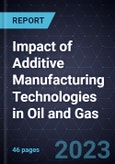On-demand Components and Shift toward Digital Inventory Drive Adoption of 3D Printing
Recent years have seen tremendous technological growth in additive manufacturing, also referred to as 3D printing, and increased research and development (R&D) activities as companies work to scale the technology and meet increasing and evolving needs across several industries. In particular, the oil and gas sector is adopting 3D printing technologies for new product development, shifting from physical to digital inventory systems to reduce its carbon footprint, and fabricating components/parts on demand at desired locations.
This research reviews the adoption of various 3D printing technologies and their application capabilities and impacts across the oil and gas industry. The technology segments are powder bed fusion (PBF), binder jetting, material jetting, material extrusion, sheet lamination, VAT polymerization, and direct energy deposition. The report also covers existing and emerging business models that industry participants adopt.
Briefly, this study covers the following elements:
- Technology segmentation
- Overview of major drivers and challenges
- Existing and emerging component analysis
- Developments by major industry participants
- Growth opportunity universe
- Future business model road map








